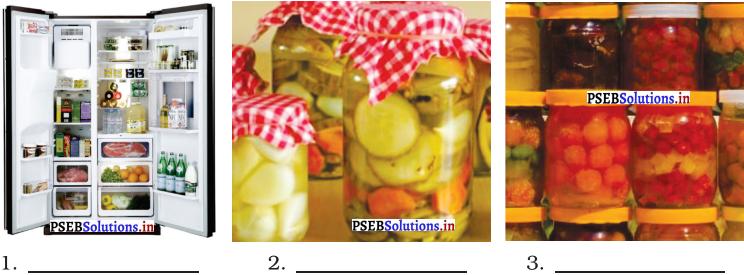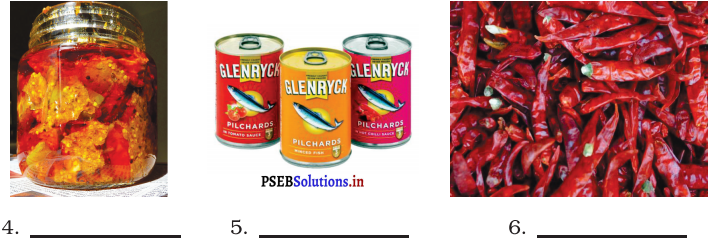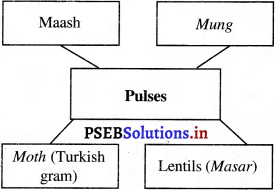Punjab State Board PSEB 5th Class EVS Book Solutions Chapter 10 Storage and Preservation of Food Textbook Exercise Questions and Answers.
PSEB Solutions for Class 5 EVS Chapter 10 Storage and Preservation of Food
EVS Guide for Class 5 PSEB 10 Storage and Preservation of Food Textbook Questions and Answers
Textbook Page No. 58
Activity 1
Students will collect the samples of different food products such as, bread, chapatti, pulses, wheat and vegetables. They will keep them in the open. After 5-6 days they will observe them and discuss, and write about them.
Answer:
Do it yourself.
![]()
Textbook Page No. 59-60
Question 1.
Which kind of food products decay soon?
Answer:
Bread, chapatti, vegetables.
Question 2.
Which kind of food products do not decay soon?
Answer:
Pulses, wheat.
Activity 1 (a)
Methods of food storage and preservation.


Answer:
1. Cooling
2. Salting
3. Adding Sugar
4. Pickle
5. Canning
6. Drying.
![]()
Activity 2
Ask your mother about the methods used for food preservation and write them in the following manner.

Answer:
| Food | Methods of Preservation |
| 1. Wheat | using insecticides, neem leaves |
| 2. Pulses | drying in sun |
| 3. Fruits Vegetables | keeping in refrigerator, making jams, murabba |
| 4. Pickle | keeping in oil |
| 5. Milk | by boiling |
Question 3.
Why is it necessary to boil milk?
Answer:
There are some bacteria in the milk which gets killed by boiling and milk can be stored for some time.
![]()
Activity 3
Textbook Page No. 61
Question 4.
What kinds of murabbas have you eaten?
Answer:
Amla, Apple, Carrot murabba.
Question 5.
How can the decaying of food be assessed?
Answer:
When we see change in colour of the food item and a bad smell is felt we come to know that food is not fit for eating.
Question 6.
What kind of food is kept in the fridge for preservation?
Answer:
Milk, green vegetables, fruits, meat, bread etc.
![]()
Activity 3
Collect and write about the information regarding packed food or medicines from the market. Note the date of packing, expiry date and time for consumption.

Answer:
Do it yourself.
Textbook Page No. 64
Question 7.
Various methods of storing the grains are discussed in the chapter. Write about the method you liked the most.
Answer:
I liked the method in which grains are dried in sun and stored in drum.
Question 8.
Why is the use of poisons harmful to preserve the pulses?
Answer:
Pulses contain proteins and proteins absorb the poison quickly. Thus, insecticides used for storing pulses are more harmful.
![]()
Question 9.
Why are fruits and vegetables kept in cold stores?
Answer:
Cold stores are like very huge refrigerators and also temperature is much below than the normal fridge temperature. At low temperatures, fruits and vegetables remain fresh for long time. Therefore, we store vegetables in a cold store.
Question 10.
Match the following :
A – B
1. Milk (a) Drying
2. Pickle of Lemon (b) Adding Sugar
3. Peppermint leaves (c) Refrigerating
4. Jamun and Grapes (d) Boiling
5. Murabba of Amla (e) Oiling
Answer:
1. (d),
2. (e),
3. (a),
4. (c),
5. (b).
PSEB 5th Class EVS Guide Storage and Preservation of Food Important Questions and Answers
1. Tick the correct option :
(i) Grains can be stored :
(a) in drums after drying ( )
(b) in gunny bags in stores ( )
(c) both true ( )
(d) none. ( )
Answer:
(c) both true
![]()
(ii) Milk can be prevented from spoiling by :
(a) placing it in sunlight ( )
(b) boiling ( )
(c) keeping in fridge ( )
(d) Both (b) and (c) ( )
Answer:
(d) Both (b) and (c)
2. Answer in one/two lines :
Question 1.
How do we know that wheat grains are dry?
Answer:
When broken with teeth, grains make a cracking sound.
Question 2.
Which preservatives are used in pickles?
Answer:
Oil and vinegar can be used to preserve pickles.
3. Fill in the blanks :
(i) In warehouses …………………. killing tablets are kept.
(ii) Milk is …………………. to prevent it from spoiling.
(iii) Vegetables are kept at …………………. temperature to prevent rotting.
(iv) Oil is used to …………………. pickle.
Answer:
(i) rat
(ii) boiled
(iii) low
(iv) preserve.
![]()
4. True/False :
(i) Pesticide tablets are used to store wheat in drums.
(ii) Gunny bags are kept close to walls in the stores.
(iii) Farmers can become prosperous by growing new high-yield varieties of crops.
Answer:
(i) T,
(ii) F,
(iii) T.
5. Match the following :
(A) – (B)
(i) Boiling (a) Fig
(ii) Adding oil (b) Murrabba
(Hi) Drying (c) Milk
(iv) Adding lot of Sugar (d) Mango pickle.
Answer:
(i) (c)
(ii) (d)
(iii) (a)
(iv) (b)
6. Mind Map :

Answer:

![]()
7. Answer in five/six lines :
Question 1.
What do you know about pasteurization?
Answer:
This is a method in which milk is heated upto high temperature and then it is cooled immediately and is packed into sealed packets or bottels. This milk can be used for many days and it becomes easy to transport from one place to other. In Punjab, Verka Milk plant is selling pasteurized milk at large scale.
Question 2.
Write down the methods used for food preservation?
| Food | Methods of preservation |
Answer:
| Food | Methods of preservation |
| Milk | by boiling it |
| Amla | by preparing murabba |
| Methi | by drying it |
| Wheat | by drying and putting it in drum and by putting neem leaves in it |
